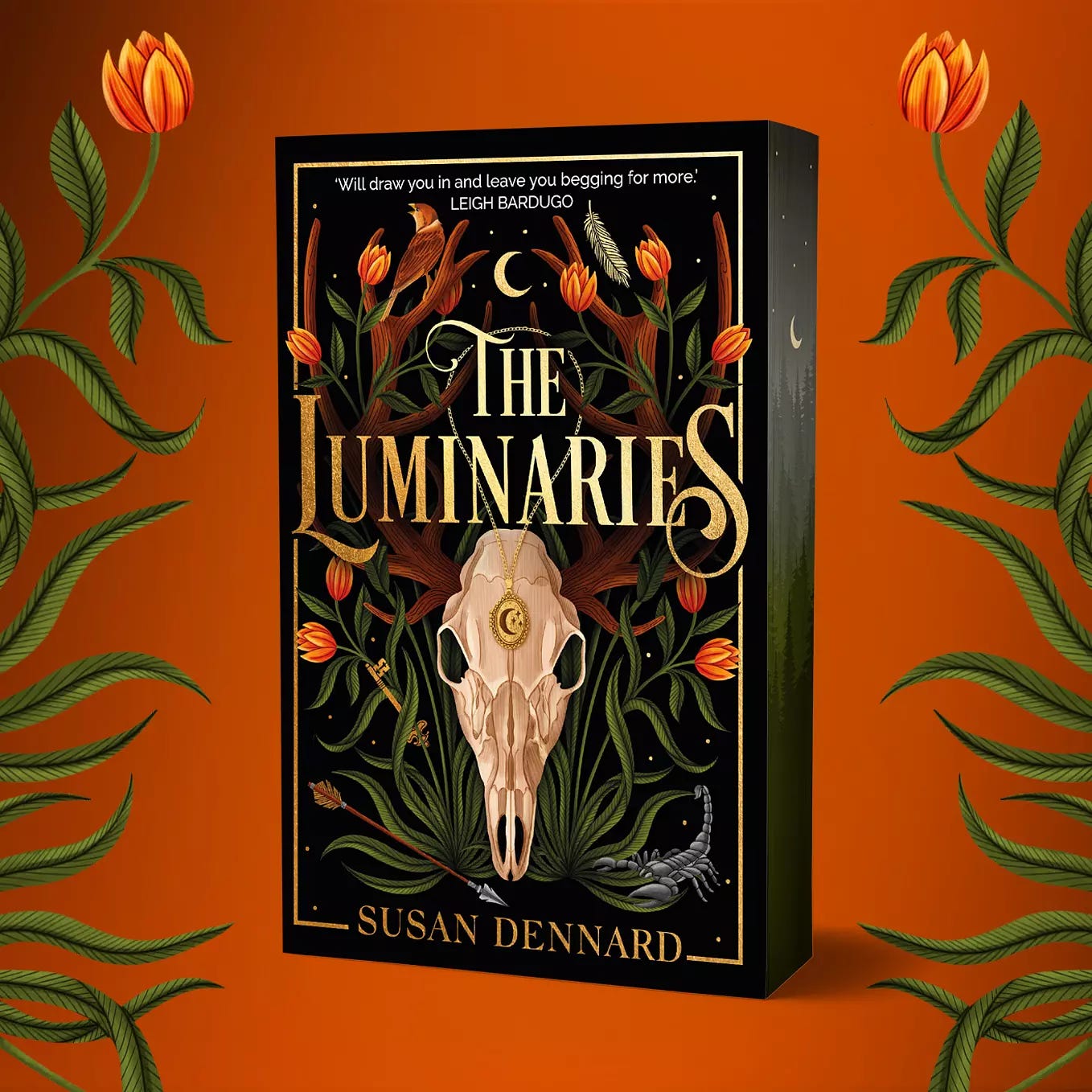An Easy Trick for Showing Instead of Telling
Deepening your POV with opinions and layers
1. Latest News from the Desk of Sooz
Happy Holidays for all my US friends! I hope you get to celebrate Thanksgiving in whatever way brings you the most joy.
And if you are in the spirit of giving, please consider donating to The Mighty Pens for our Direct Relief fundraiser this NaNoWriMo.
I just turned in the second Luminaries book after a second round of edits, and that sucker is almost ready to head off into production! It was a beast to write, but all that hard work up front has led to some pretty easy, painless rounds of editorial.
(P.S. Thank you to all my lovely beta readers who have also been reading when my editor did!)
In case you missed it, these were my most recent newsletters:
Ask Me Anything #2 (paid only!)
You’re Not a Failure (paid with a preview)
2. Writing Prompts
SHORT STORY ✍️
Each night, when the stars rise, a fairy-like creature appears in a young boy’s bedroom. Is it friend or foe? And what is the haunting tune it keeps singing?
JOURNALING ✍️
I got a lot emails (and comments) on my post about Taking the Time to Heal, and it’s clear this is a universal problem. Where can you give yourself more grace? And where can you allow yourself more healing space?
3. For the DenNerds: UK Luminaries Special Editions
Hey LumiNerds, have you seen the Waterstones special edition of The Luminaries? It has these gorgeous sprayed edges, and of course, all the UK editions have illustrated nightmares within…
Make sure you preorder before January 26th, 2023! We might have some very epic preorder gifts coming your way, if you do…😏
And of course, if you don’t want to wait to read, UK readers can order the ebook right now! It’s already for sale on major retailers!
Also, Forbidden Planet has a signed edition to preorder, so don’t miss that version either!
4. For the Daydreamers: An Easy Trick for Showing Instead of Telling
This post was inspired by something that occurred to me recently. It’s about the real meaning behind the old adage: show, don’t tell.
And it’s about POV and what makes something deep POV versus a more limited third or first (or hey, if you’re writing Sooz Your Own Adventures, then limited second).
One of the most common lessons I see used when explaining show vs. tell is the famous Anton Chekhov quote:
“Don't tell me the moon is shining; show me the glint of light on broken glass.”
Look, that’s all fine and well. I don’t disagree at all. But it doesn’t give you the whole picture of what really makes something feel “shown” versus “told.”
You can’t just tell me the moon is shining or show me the glint of light. The reader also needs to know what the character is experiencing. Physically, visually, viscerally—it’s that whole “awaken all five senses.”
I enter the living room to find my bay window shattered and the night’s moon glinting on broken glass. I cross toward the glass sprayed across my scarlet rug. The thick pile soaks up the sound of my bare heels. A frozen breeze sweeps against me. A lone leaf rattles on the barren oak outside, and branches creak.
I know it’s Tyler doing that—his way of laughing at me from beyond the grave.
Okay, the picture is clear enough.
But let’s be real: it’s still really flat, isn’t it?
Now let’s add some emotions and visceral reactions to the scene—because that too is also a key part of showing!
I enter the living room to find my bay window shattered and the night’s moon glinting on broken glass. Fury rises inside me; my heart picks up speed. I cross toward the glass sprayed across my scarlet rug. The thick pile soaks up the sound of my bare heels. A frozen breeze sweeps against me. A lone leaf rattles on the barren oak outside, and branches creak.
I know it’s Tyler doing that—his way of laughing at me from beyond the grave.
It’s better, but honestly, it could be better. Like way better.
So what do we need to really show the scene is to deepen the POV? It’s the opinion of the character.
In the past, when I’ve tried to explain this to beginners whose work I’m critiquing, I will frequently say, “I want more internal narration here. I want to see more thoughts. Give me their unique lens on this situation.”
(I’m sure a few of you are glaring at me right now. SORRY. 😬)
While that list is an accurate way to describe what I’m requesting, I’m not sure it’s ever actually made sense. Like, I’ve always been on the hunt for a better way to explain to those writers what I actually think is missing.
A few days ago, however, it hit me that what I’m really asking for is the character’s opinion.
Google tells me an opinion is “a view or judgment formed about something, not necessarily based on fact or knowledge.” That means that an opinion is a combination of what we think and feel—a.k.a. a unique lens contained within a series of thoughts.
So let’s take the above quotation and rework it to now include the character’s opinion on everything.
I enter the living room to find my bay window shattered and the night’s moon glinting on broken glass. Fury rises inside me. Effing Tyler. I know it was effing Tyler because it’s always effing Tyler. This time, though, he has gone too far.
My heart picks up speed as I cross toward the glass sprayed across my scarlet rug. The thick pile soaks up the sound of my bare heels. A frozen breeze sweeps against me, not that I feel it with all this rage. I am heat from the inside out, and visions of Tyler very, very dead dance across my brain.
I made him that way, you know.
A lone leaf rattles on the barren oak outside, and branches creak. Tyler again because it’s always effing Tyler. This is his way of mocking me from beyond the grave. Of saying, You might have killed me, but I’ll always have the final laugh.
That’s a ton more internal narration, isn’t it? It’s more visceral reaction as well because once I settled into my narrator’s head to access their opinions, I started feeling more of their physicality too.
Years and years ago, a friend of mine (author Erica O’Rourke) told me she writes steamy romantic scenes by writing two phrases of physical description followed by one phrase of internal reaction.
His hands slide up my back. His lips graze my throat. My god, Tyler is much better at this now that he’s dead.
(Yikes. I literally have no idea what I’m writing here and I’m making it up as I go. 😅)
That rule of 2:1 is loose, of course. It’s a rhythm you feel through as you draft and revise. But it’s also useful to constantly remember—to keep in the back of your head while you draft or revise.
Are things falling flat? Do I have enough opinions on the page? How much physical descriptor do I have before I have included some internal narration?
Try it! Take a page from one of your manuscripts and see what the ratio actually is. Or take a page from one of your favorite books and see what the ratio is there. Everyone’s tastes will be different, so finding the ratio YOU like best can help you with your writing.
One final thing before I go: I very rarely have enough internal narration in my first draft.
In fact, my first drafts are usually spare in all sorts of details, ranging from sensory to world building to opinion. As such, my first drafts usually come in pretty short. Then I will cycle through the book, and with each new draft, I layer in more of what’s missing.
This allows me to improve pacing, to deepen POV, to show more instead of tell, and to generally strengthen my prose with each new pass. Sometimes I do this “cycling” as I am drafting.
Like this very morning, I opened a scene I wrote yesterday, and as I read through to orient myself for the day’s work, I added more sensory detail and internal narration. Easy peezy, the lemon was squeezied.
Other times, I’ll wait until I have hit my usual 15,000-20,000 word wall, and then I’ll go back and layer in what I need.
There’s no wrong time or wrong way to do it—and no limit on how many passes you can take. And maybe, if you’re lucky, you never will need to go back for layering because you’ll be able to get it write on your first draft!
Thank you all so much for reading! I hope you have a great week, and I’ll be back in your inbox again soon!
🐙 - Sooz




Thanks SO much for this! Definitely a weak area of my writing. I like to blame being an enneagram 5.
Thanks for this post, Sooz 😊. I have definitely recognized that in early drafts there is no explanation of what the thing means to the character experiencing it, so then readers have no idea how to interpret it also. You hit the nail on the head.